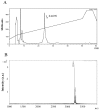Subtilomycin: a new lantibiotic from Bacillus subtilis strain MMA7 isolated from the marine sponge Haliclona simulans
- PMID: 23736764
- PMCID: PMC3721211
- DOI: 10.3390/md11061878
Subtilomycin: a new lantibiotic from Bacillus subtilis strain MMA7 isolated from the marine sponge Haliclona simulans
Abstract
Bacteriocins are attracting increased attention as an alternative to classic antibiotics in the fight against infectious disease and multidrug resistant pathogens. Bacillus subtilis strain MMA7 isolated from the marine sponge Haliclona simulans displays a broad spectrum antimicrobial activity, which includes Gram-positive and Gram-negative pathogens, as well as several pathogenic Candida species. This activity is in part associated with a newly identified lantibiotic, herein named as subtilomycin. The proposed biosynthetic cluster is composed of six genes, including protein-coding genes for LanB-like dehydratase and LanC-like cyclase modification enzymes, characteristic of the class I lantibiotics. The subtilomycin biosynthetic cluster in B. subtilis strain MMA7 is found in place of the sporulation killing factor (skf) operon, reported in many B. subtilis isolates and involved in a bacterial cannibalistic behaviour intended to delay sporulation. The presence of the subtilomycin biosynthetic cluster appears to be widespread amongst B. subtilis strains isolated from different shallow and deep water marine sponges. Subtilomycin possesses several desirable industrial and pharmaceutical physicochemical properties, including activity over a wide pH range, thermal resistance and water solubility. Additionally, the production of the lantibiotic subtilomycin could be a desirable property should B. subtilis strain MMA7 be employed as a probiotic in aquaculture applications.
Figures






Similar articles
-
ApnI, a transmembrane protein responsible for subtilomycin immunity, unveils a novel model for lantibiotic immunity.Appl Environ Microbiol. 2014 Oct;80(20):6303-15. doi: 10.1128/AEM.02280-14. Epub 2014 Aug 1. Appl Environ Microbiol. 2014. PMID: 25085495 Free PMC article.
-
Diversity and bioactive potential of endospore-forming bacteria cultured from the marine sponge Haliclona simulans.J Appl Microbiol. 2012 Jan;112(1):65-78. doi: 10.1111/j.1365-2672.2011.05173.x. Epub 2011 Nov 8. J Appl Microbiol. 2012. PMID: 21985154
-
Sublichenin, a new subtilin-like lantibiotics of probiotic bacterium Bacillus licheniformis MCC 2512T with antibacterial activity.Microb Pathog. 2019 Mar;128:139-146. doi: 10.1016/j.micpath.2018.12.044. Epub 2018 Dec 27. Microb Pathog. 2019. PMID: 30594640
-
Lantibiotics, class I bacteriocins from the genus Bacillus.J Microbiol Biotechnol. 2011 Mar;21(3):229-35. J Microbiol Biotechnol. 2011. PMID: 21464591 Review.
-
Bacillus subtilis antibiotics: structures, syntheses and specific functions.Mol Microbiol. 2005 May;56(4):845-57. doi: 10.1111/j.1365-2958.2005.04587.x. Mol Microbiol. 2005. PMID: 15853875 Review.
Cited by
-
Probiotics and Their Bioproducts: A Promising Approach for Targeting Methicillin-Resistant Staphylococcus aureus and Vancomycin-Resistant Enterococcus.Microorganisms. 2023 Sep 25;11(10):2393. doi: 10.3390/microorganisms11102393. Microorganisms. 2023. PMID: 37894051 Free PMC article. Review.
-
Characterization of plant growth-promoting rhizobacteria from perennial ryegrass and genome mining of novel antimicrobial gene clusters.BMC Genomics. 2020 Feb 12;21(1):157. doi: 10.1186/s12864-020-6563-7. BMC Genomics. 2020. PMID: 32050906 Free PMC article.
-
Diverse LXG toxin and antitoxin systems specifically mediate intraspecies competition in Bacillus subtilis biofilms.PLoS Genet. 2021 Jul 19;17(7):e1009682. doi: 10.1371/journal.pgen.1009682. eCollection 2021 Jul. PLoS Genet. 2021. PMID: 34280190 Free PMC article.
-
Identification and classification of known and putative antimicrobial compounds produced by a wide variety of Bacillales species.BMC Genomics. 2016 Nov 7;17(1):882. doi: 10.1186/s12864-016-3224-y. BMC Genomics. 2016. PMID: 27821051 Free PMC article.
-
Biocontrol properties from phyllospheric bacteria isolated from Solanum lycopersicum and Lactuca sativa and genome mining of antimicrobial gene clusters.BMC Genomics. 2022 Feb 21;23(1):152. doi: 10.1186/s12864-022-08392-0. BMC Genomics. 2022. PMID: 35189837 Free PMC article.
References
-
- Kennedy J., Baker P., Piper C., Cotter P.D., Walsh M., Mooij M.J., Bourke M.B., Rea M.C., O’Connor P.M., Ross R.P. Isolation and analysis of bacteria with antimicrobial activities from the marine sponge Haliclona simulans collected from Irish waters. Mar. Biotechnol. (NY) 2009;11:384–396. doi: 10.1007/s10126-008-9154-1. - DOI - PubMed
Publication types
MeSH terms
Substances
LinkOut - more resources
Full Text Sources
Other Literature Sources

